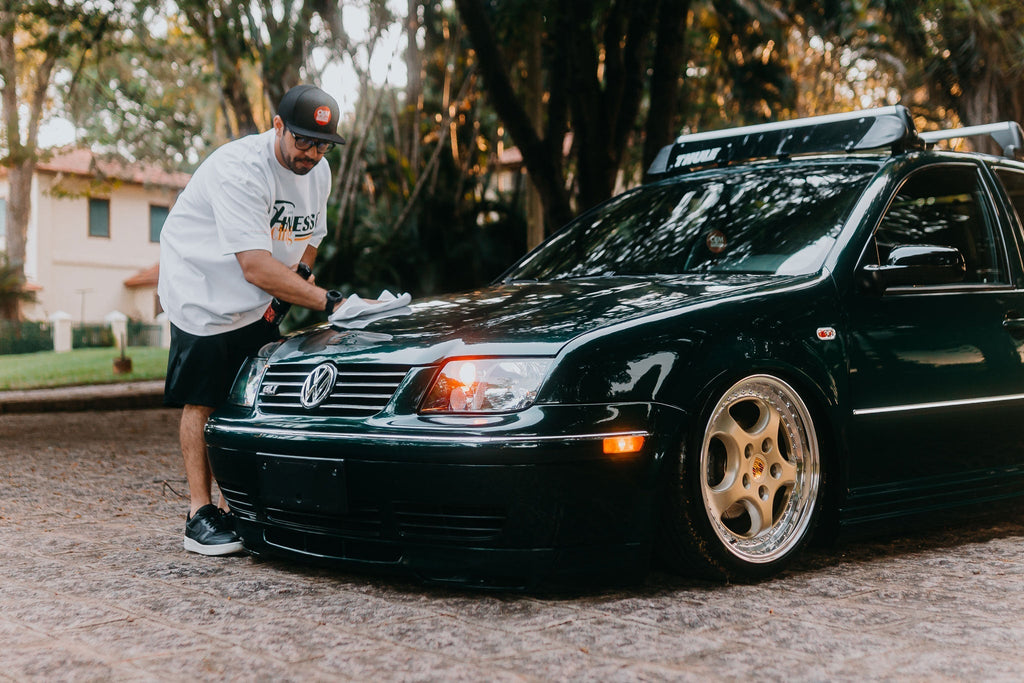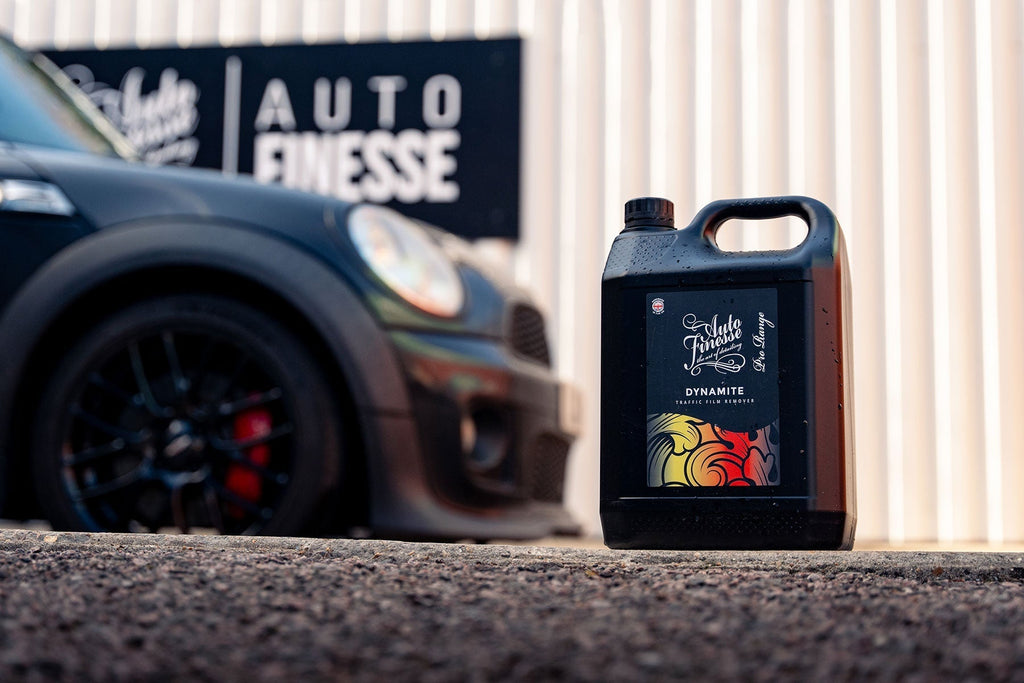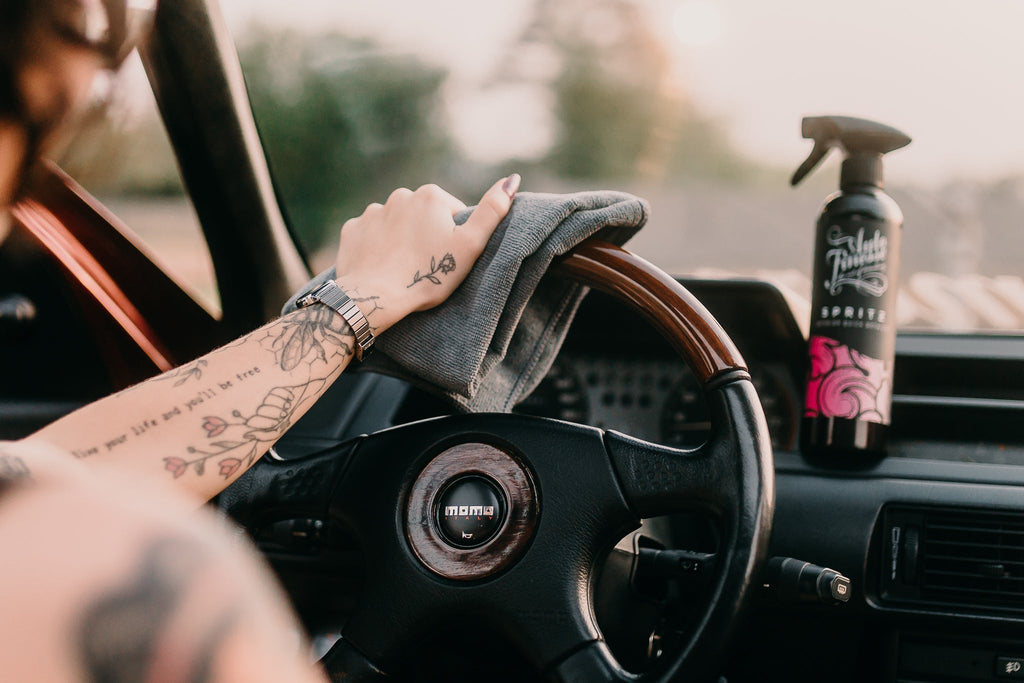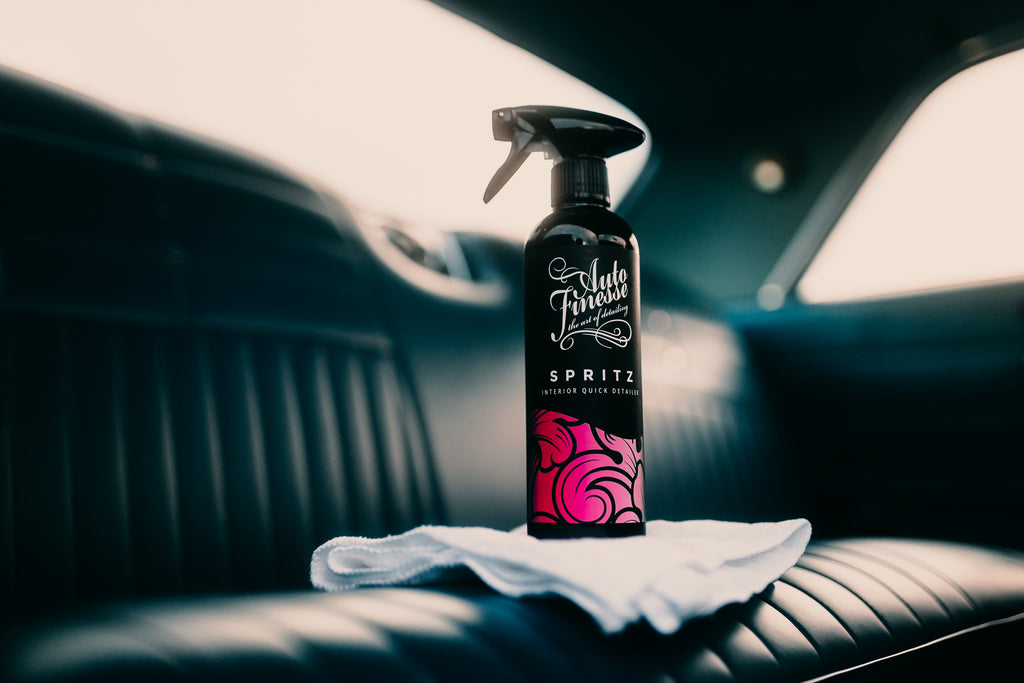Detailing A Super Bike

In This Guide You Will:
- Learn how to clean, improve, and finish your motorbike safely, just like the pros.
- Explore the products you'll need and master each step with our easy-to-follow guide.
- Clear up common myths about cleaning engines and enhancing plastic panels.

What Are The Benefits?
- Learning how to clean, protect, and maintain your motorbike helps preserve its value and prevent mechanical issues.
- A thorough detail now makes future maintenance much easier.
- Using the right products and techniques saves time, money, and eliminates potential risks.
How Is Cleaning A Motorbike Different To Cleaning A Car?
It's true that some of the fastest and most sought-after vehicles on the road have two wheels instead of four, and many car enthusiasts have a motorbike tucked away in their garage. But when it comes to effective detailing, how does it all work?
Our customer service team is frequently asked about the differences between detailing cars and motorbikes, and how everything from high-performance superbikes to daily-driven tourers can be cleaned, enhanced, and protected without damaging any parts of the vehicle. These are important questions, and we believe they deserve clear answers. So, let us explain how the pros do it...

What Is The Difference Between A Motorbike And A Car?
Aside from the obvious difference – two wheels versus four – there isn’t a huge distinction between detailing a car and detailing a motorbike. In fact, most of the processes we use on cars can be applied, or at least adapted, for bikes. Like cars, motorbikes can be washed, decontaminated, enhanced, polished, protected, and maintained throughout any season. The key is to approach each step with caution and good judgment.
There are a few subtle differences, of course. Bikes don’t have interiors, so their seats and even gauges are designed for outdoor exposure, making them tougher and more resistant to stronger cleaning solutions than the leather or upholstery found inside a car.
However, it’s also clear that motorbikes shouldn’t be underestimated when it comes to effective cleaning and finishing. Some argue that detailing a bike is easier than a car because of its smaller size. After all, there's less to polish, protect, or refine, right? But in reality, while bikes may give you more time to work on certain areas, they can be more intricate and contain more dirt traps than cars. It's really a case of "six of one, half a dozen of the other."

Step-By-Step Enhancement
Here’s how to perform an effective enhancement detail, including key areas to focus on when cleaning your motorbike, along with plenty of additional tips to elevate your detailing process...



Step 1 - Inspection
As with any detailing project, the level of work required will vary depending on factors like the vehicle’s condition, its construction, how it's driven, and even its age.
When it comes to motorbikes, the main difference is that every part is exposed to the elements. While this means sensitive components like air filters and electrics are generally better protected compared to cars, caution is still needed when using a pressure washer. Instead of blasting water directly, it’s better to lightly mist areas that could be problematic. Treat detailing a bike much like rinsing a car engine bay—take your time and be cautious. For older or modified bikes, pay extra attention to exposed electrics or open filters.
Motorbikes often have more intricate metal components on display. While this is less of an issue on sports bikes, it’s quite noticeable on larger touring bikes, like a Harley Davidson, where polishing can take some time—Mercury Metal Polish works wonders here!
Start by inspecting your motorbike and making a plan for what’s needed. In this case, we’re performing an enhancement detail on a well-maintained, though slightly dirty, BMW S1000R. While full decontamination and paint correction aren’t necessary, it’s important to consider how deep you want to go and what results you hope to achieve with the time you have.
One immediate consideration is the exhaust design. Like with cars, water on the engine isn’t a problem, but water inside the engine can be. As a precaution, we inserted a couple of old work cloths into the tailpipes to avoid water infiltration and to minimize the risk of damage when spraying water.

Step 2 - Wheels
Unlike a car detail, where we typically start with the engine bay, with a bike, the first step is always the wheels.
Bikes are generally lighter than cars, which means they don’t accumulate as much brake dust. In fact, if you notice rusty spots that require treatment with Iron Out Fallout Remover on the fairings or mudguards, it likely came from other vehicles on the road.
Many bike wheels and brake calipers feature chrome or other specialized finishes, so we avoid using harsh fallout removers on them. Instead, a combination of Imperial Acid-Free Wheel Cleaner and Revolution Wheel Shampoo is perfect for removing brake dust and grime while being safe for all wheel surfaces.
Start by rinsing the wheels to remove any loose contaminants. Then, add 2-3 capfuls of Revolution Wheel Shampoo to a bucket of clean water and agitate with your pressure washer.
Work on one wheel at a time. Begin by applying Imperial Acid-Free Wheel Cleaner liberally over the spokes and barrel. Then, use the Revolution solution to carefully clean every detail, including around the brake calipers. This will break down grime and lift brake dust, trapping it in the slick solution.
For a final clean, use Revolution Wheel Shampoo on a dedicated wash mitt to ensure thorough agitation of all areas. Rinse away the residue and dirt for a spotless finish.





Step 3 - Tyres
Cleaning tyres on a sports bike is crucial, perhaps even more so than on a car. It's not just because the tyres are visible most of the time, but because we avoid using tyre dressings on motorcycle tyres to prevent any loss of grip during cornering. This means there’s no hiding any dirt or grime.
Tread Tyre Cleaner is the perfect solution for this, and when paired with our Rubber Scrubber Tyre Brush, it quickly breaks down heavy soiling and road grime. Even stubborn stains and browning are easily removed. Simply apply the cleaner to the entire tyre, scrub it in, and rinse off for a thorough clean.




Step 4 - Pre-Wash
When it comes to the main body of the bike, a thorough prewash is essential to remove heavy grit and grime, preventing swirl marks on the paint and gloss plastics. The best prewash can only be achieved with the right cleaning agent that effectively breaks down dirt, allowing it to be safely rinsed away.
For this, we recommend Citrus Power Bug & Grime Remover. It’s strong enough to tackle contamination but gentle on sensitive surfaces, and it won't strip any waxes or coatings previously applied.
Start by rinsing the entire bike from top to bottom to ensure the pre-cleaner reaches all the necessary areas. Then, generously spray Citrus Power, focusing on the most contaminated spots such as the fairings, tank, and frame. Allow the solution to dwell and work its magic.
What sets motorcycle detailing apart from car detailing at this stage is the use of Eradicate Engine Degreaser for any greasy parts. Just remember, avoid cleaning the chain as it needs lubrication—though getting it wet or covered in snow foam during the wash is fine.
Liberally apply Eradicate to the greasy areas, then let it dwell. There’s no need to scrub or rinse yet. For an extra boost of cleaning power, we’ll follow up with Avalanche Snow Foam.



Step 5 - Snow Foam
Let’s start with a commonly asked question: Is it safe to use Avalanche Snow Foam on a motorbike? The answer is yes! Motorbikes are built to withstand all sorts of weather conditions, including snow during winter, so a generous layer of citrus-infused snow foam won’t cause any issues. Plus, Avalanche is designed to penetrate every nook and cranny, which is crucial when cleaning bikes—after all, they are far more intricate to clean than flat car panels.
Using your Snow Foam Lance, apply Avalanche to the entire bike, starting from the top and working your way down. Let the foam dwell for as long as possible to allow it to break down the grime. While it’s dwelling, take a Detailing Brush and gently agitate the foam into the most intricate areas. If needed, add more Citrus Power for deeper cleaning as you work your way through the details.



Step 6 - Degrease And Rinse
Motorbikes tend to have more greasy areas on the exterior than cars, particularly on intricate parts like sprockets and engine components. For these areas, you can apply a bit more Eradicate and use a brush to break down the remaining grease and grime—just be sure to avoid direct contact with the chain.
Once you've agitated the dirtiest spots and lifted contaminants from the surfaces, it’s time to thoroughly rinse the entire bike. Take your time with this step, as the Avalanche, Citrus Power, and Eradicate solutions will have trapped the dirt, and the goal is to safely rinse it off and away from the bike. Be sure to do a thorough rinse to ensure no residue remains.



Step 7 - Contact Wash
Since this particular bike is relatively new and has low mileage, it doesn’t require a full 3-stage decontamination. As a result, the contact wash will be the final step of the wash process. However, this doesn't mean decontamination isn’t still an option. Depending on the condition, you might need to use Iron Out for removing embedded metal particles, ObliTARate for sticky residues, or detailing clay with Glide lubricant to remove contaminants like overspray and bird droppings. These steps should be decided on a case-by-case basis.
For the wash itself, the standard procedure applies. Use two Detailing Buckets—one for your wash solution and the other for rinsing out your wash mitt between passes. A high-quality car shampoo will help lift and lubricate any remaining grime, making it easier to rinse away. Always wash in straight lines, starting with the least contaminated areas, and be thorough when rinsing to ensure all the grime is removed.



Step 8 - Drying
Just like with cars, drying a motorbike properly is crucial to avoid water spots and stains caused by minerals and impurities in rinse water. It's often when water is left to air dry that problems arise. Drying a bike can be trickier, though, because of the numerous recesses where water can drip out. Professional detailers often use air blowers or compressed air to get as much water out as possible before using drying towels to mop up any remaining drips.
However, if you don't have access to that equipment, you can still achieve great results with a high-quality drying towel, such as the Aqua Deluxe or Silk drying towel. Use these towels on the larger panels, and then give the bike a quick shake to remove any excess water that may drip out. Repeat the process a couple of times to ensure all the water is removed for a spotless finish.

Step 9 - Enhancement And Protection
At this stage, you have a decision to make. While machine polishing painted surfaces like tanks is possible, it’s essential to avoid any graphics and badges. Keep in mind that many modern bike panels are made of plastic, which doesn’t dissipate heat as efficiently as metal. When machine polishing, it’s wise to use shorter passes to prevent overheating the plastic. Always perform correction work only when necessary to remove swirl marks and defects—not as a routine step.
Hand polishing with a product like Tripple car polish is another great option, especially for removing light swirling and oxidation while leaving a protective carnauba layer. In this case, since there were no visible defects, we opted for Rejuvenate paintwork cleanser and a microfiber polishing pad to remove slight oxidation and prepare the surface for a coat of Desire carnauba wax.
As with any vehicle, paint protection is crucial. On a motorbike, this step should be applied to all painted panels, including tanks, fairings, and body parts. The choice of protection product will depend on your preferences and circumstances. For a glossy, deep finish, we recommend a hard wax, which is what we used for this well-maintained weekend bike. If you're preparing a bike for harsher conditions, such as winter, consider using Ceramic protection from our Caramics Paintwork Protection Kit. Alternatively, if you're short on time, options like Glisten Spray Wax or Radiance Liquid Carnauba Wax offer excellent protection with minimal effort. The key takeaway is to always apply protection, whether after an enhancement detail, full correction, or anywhere in between. With detailing, you have the flexibility to customize your approach to suit your specific project needs.






Step 10 - Screens
Under normal conditions, the Perspex screens on motorbikes can be easily and effectively cleaned with a quick spray of Crystal Glass Cleaner. This specially formulated blend of mild distilled solvents cuts through grease, grime, and fingerprints, quickly evaporating to leave a crystal-clear finish. It’s a powerful solution for routine cleaning.
However, if your bike has been exposed to the elements—especially if it’s stored outside or used in all weather—you may encounter a screen that needs a bit more attention. Perspex screens are prone to scratches, etching from bug splatter, and water spots, particularly on the inside where it’s difficult to wipe away residue. In these cases, the best approach is to remove the screen and use Vision Glass Polish to eliminate spots and light defects. For added cleaning power, a Microfibre Spot Pad is perfect for tackling deeper issues and restoring clarity.
Once the screen is back in place, finish off with a quick wipe of Crystal Glass Cleaner to remove any fingerprints or smudges, and you're all set!






Step 11 - Finishing Up
The final finishing steps will vary depending on your bike's specific features. If your pride and joy is adorned with chrome accents or numerous metal parts, you might even have the task of polishing the engine itself! However, for many modern superbikes, exposed metal components are limited, often just the exhaust tips and a few other areas. In these cases, Mercury Metal Polish is the ideal choice. Its light abrasive formula quickly removes oxidation and strips away a thin layer of the surface, revealing fresh metal beneath—cleaning and restoring in one easy step. If you're tackling heavier contamination, Mercury Xtreme Metal Polish offers a more powerful solution for the job.
For the final step, consider adding protection to your wheels. There are several options depending on your needs. For ultimate ceramic protection, the Caramics Wheel Protection Kit is a top choice. Alternatively, you can enhance and protect your rims with Mint Rims Wheel Wax, or for a quicker option, a spritz of Glisten Spray Wax provides up to a month of protection and makes your wheels easier to clean during your next detail.












